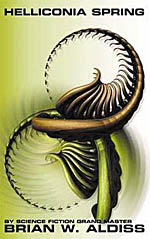
![]() charlesdee
charlesdee
7/11/2012
![]()
I guess I am joining the chorus of voices who express frustration if not outright disappointment with this book. Aldiss has written several sf novels that are among my favorites Hot House, Greybeard, The Dark Light Years and I was looking forward to this trilogy. But as other reviewers tend to point out, if you glance at the reader responses to all three books, the number or respondents drops book by book. Helliconia Spring, although it certainly has its fans, I found to be pretty rough going.
Aldiss has meticulously imagined his Ice Age world facing the coming of a thaw that occurs only every 1000 years or so. The planet Helliconia is part of a binary star system. It's short year around Batalix is 400 plus days, but Batalix carries Helliconia with it in orbit around Freyr in a year the equivalent of 2592 earth years. Few Helliconians ever witness a change of season, and those changes are so separated in time that knowledge of them and their consequences is either lost or the subject of legend. The coming of Spring causes some forces in Olderando, the novel's main setting, to entrench themselves in old ways while others, especially a group of women, throw themselves into the pursuit of knowledge that will make sense of their changing world. That world is threatened by Phagors, creatures like mean Chewbaccas that are primordial enemies of humans, the societal changes that increased population and mobility bring, and a virus activated by the cwarming climate.
Scientists from Earth survey these changes from an orbiting space station called the Avernus. (Why is this space station named after the entry to the underworld from Roman mythology?) I was curious to know more about what was going on with the Earth scientists, but I did not wish another 100 pages added to this already long novel. But Aldiss uses their presence to establish with one elegant scene just what a "long game" he is playing. The Avernus has orbited Helliconia for centuries if not longer. Technology on the ship allows the observers to follow in detail the developments among the various races and even particular people on the planet. They beam them back to earth, and these broadcasts are watched by millions is specially built theaters. But because of the time involved in sending the broadcasts, this futuristic form of reality TV takes place a thousand years after the events themselves. The long dead broadcasters and protagonists are entertaining multitudes who were centuries away from existence when these event took place. Aldiss is concerned with storytelling on a cosmic scale.
If only the story was a bit more engaging. The characters' fates are sealed by the climactic changes they cannot comprehend. I am not inclined to pick up another 400 page book to witness what I can only imagine will be approximately the same fate unfurl for a new set of Helliconians.
http://www.potatoweather.blogspot.com